| Contents
Home
General
Info
Ordering
Info
Contact us
Cartridge
Lists
Patent & Miscellaneous
Rim Fire
Center Fire Pistol
Center Fire Rifle
Metric Rimfire,
Pistol&Rifle
British Pistol and Rifle
Shotgun Shells
Cartridge Boxes &
Related
Posters
This Month's Picture Page
Index to
Picture Pages
Prior Picture Pages:
*
September 2003
*
October 2003
*
November 2003
*
December 2003
*
January 2004
*
February 2004
*
March 2004
*
April 2004
*
May 2004
*
June 2004
*
July 2004
*
August 2004
*
September 2004
*
October 2004
*
November 2004
*
December
2004
*
January 2005
*
February
2005
*
March
2005
*
April
2005
*
May 2005
* June 2005
* July 2005
*
August 2005
*
September
2005
*
October 2005
*
November 2005
*
December 2005
*
January 2006
*
February 2006
*
March 2006
*
April 2006
*May 2006
*June 2006
*July 2006
*August
2006
*September
2006
*October
2006
*November
2006
*December
2006
*January
2007
*February
2007
*March
2007
*April
2007
*May
2007
*June
2007
*July
2007
*August
2007
*September
2007
*October
2007
*November
2007
*December
2007
*January
2008
*February
2008
*March
2008
*April
2008
*May
2008
*June
2008
*July
2008
*August
2008
*September
2008
*October
2008
*November
2008
*December
2008
*January
2009
*February
2009
Links to Other Sites
Cartridge Collectors Organizations:
IAA
ECRA
SAAACA
Auctions:
Auction
Arms
E-Bay
Ward's Collectibles
Sold USA
Books:
Armory
Publications
WCF Publications
Other Collector's Sites:
Curtis Steinhauer
|
Home of the Old Ammo Guy's Virtual
Cartridge Trading Table
Featuring a wide range of antique,
obsolete, and modern ammunition for collectors
Picture
Page
March 2009
The 9.95m/m (.38) Tesching needlefire cartridge........
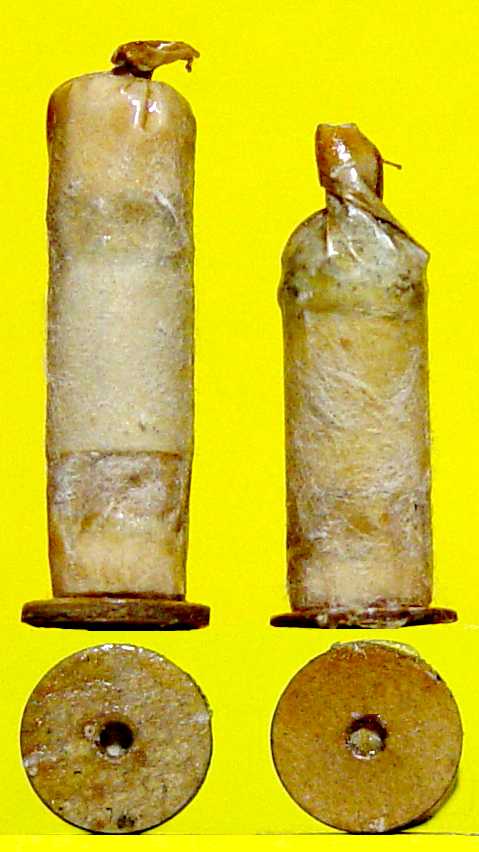
The two cartridges in this picture are variations of the 9.95 m/m Tesching needlefire cartridge,
the one on the left being a shot load and the one on the right a
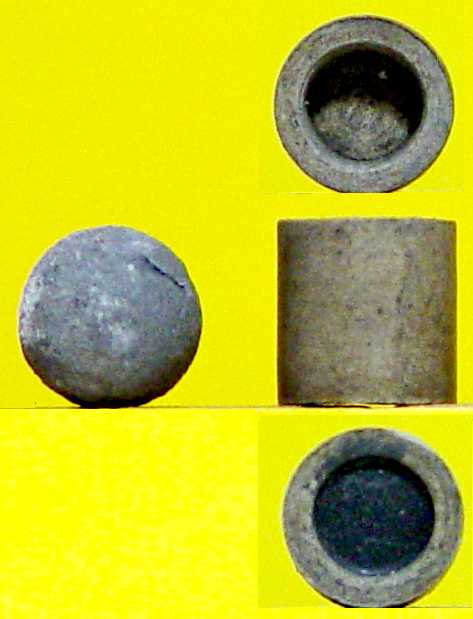 ball
load. Both have a paper sabot with a cup in each end, one for the
shot or ball to seat in and the other holding a disc of priming
compound. The powder charge is situated below the base of the wad. All of
the inner components are wrapped in a paper envelope that is closed at the
base and twisted or tied at the mouth. Attached to the thin paper base is a
cardboard disk with a hole in the center, the disk serving to protect the
fragile base as well as to form the rim. The needle, essentially a long
sharp firing pin, passes through the hole in the disk and through the powder
charge, striking the priming in the base of the wad with sufficient force to
detonate it and the powder charge. These two cartridges are
uncharacteristically shiny due to a previous owner having coated them with
shellac. The sabots in both are evident as the whiter-colored center portion
of the cartridge. ball
load. Both have a paper sabot with a cup in each end, one for the
shot or ball to seat in and the other holding a disc of priming
compound. The powder charge is situated below the base of the wad. All of
the inner components are wrapped in a paper envelope that is closed at the
base and twisted or tied at the mouth. Attached to the thin paper base is a
cardboard disk with a hole in the center, the disk serving to protect the
fragile base as well as to form the rim. The needle, essentially a long
sharp firing pin, passes through the hole in the disk and through the powder
charge, striking the priming in the base of the wad with sufficient force to
detonate it and the powder charge. These two cartridges are
uncharacteristically shiny due to a previous owner having coated them with
shellac. The sabots in both are evident as the whiter-colored center portion
of the cartridge.
.
.
Two early 7.62 x 51 (NATO) headstamps.....
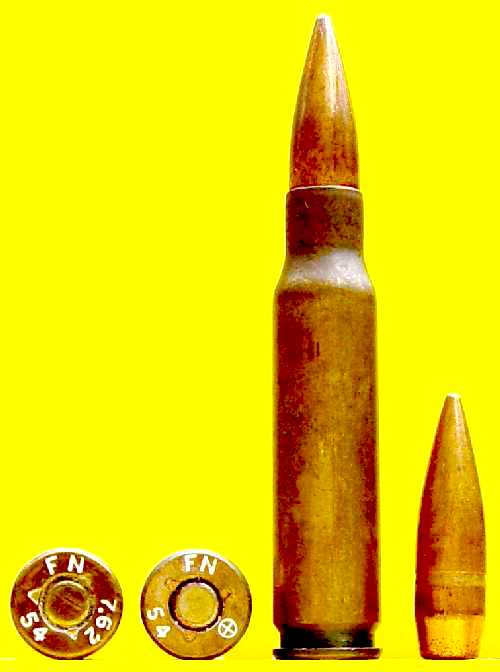 Here
are two variations of the first 7.62 x 51 cartridges produced in quantity by
Fabrique Nationale in Belgium. These were made in 1954, probably intended
for use in trials of the Belgian FN FAL rifle that was being evaluated by a
number of counties at that time. Canada was the first country to
adopt the FN FAL in 1955. The earliest headstamp is on the left; at some
point during the year, the headstamp was altered, replacing the '7.62' with
the NATO symbol. This is believed to be the first use of the NATO symbol on
the 7.62 x 51, which was adopted as the NATO standard rifle cartridge in
January, 1954. Here
are two variations of the first 7.62 x 51 cartridges produced in quantity by
Fabrique Nationale in Belgium. These were made in 1954, probably intended
for use in trials of the Belgian FN FAL rifle that was being evaluated by a
number of counties at that time. Canada was the first country to
adopt the FN FAL in 1955. The earliest headstamp is on the left; at some
point during the year, the headstamp was altered, replacing the '7.62' with
the NATO symbol. This is believed to be the first use of the NATO symbol on
the 7.62 x 51, which was adopted as the NATO standard rifle cartridge in
January, 1954.
I assume the cross in a circle symbol on the headstamp is a simple
representation of the star on a circle
 design
of the NATO flag. It is supposed to be used only on ammunition produced at NATO-approved
facilities in member countries, and indicates that the ammunition meets
strict interchangeability standards for velocity, chamber pressure, barrel
erosion, waterproofing, and a number of other characteristics. design
of the NATO flag. It is supposed to be used only on ammunition produced at NATO-approved
facilities in member countries, and indicates that the ammunition meets
strict interchangeability standards for velocity, chamber pressure, barrel
erosion, waterproofing, and a number of other characteristics.
.
Those early W.R.A.Co. .32 Long (center
fire) boxes....
Here are two early variations of Winchester two piece boxes of .32 long
centerfire cartridges. This cartridge is the American version of the British
.320 long centerfire originally made for use in the Webley and Tranter
pocket revolvers, even though its case
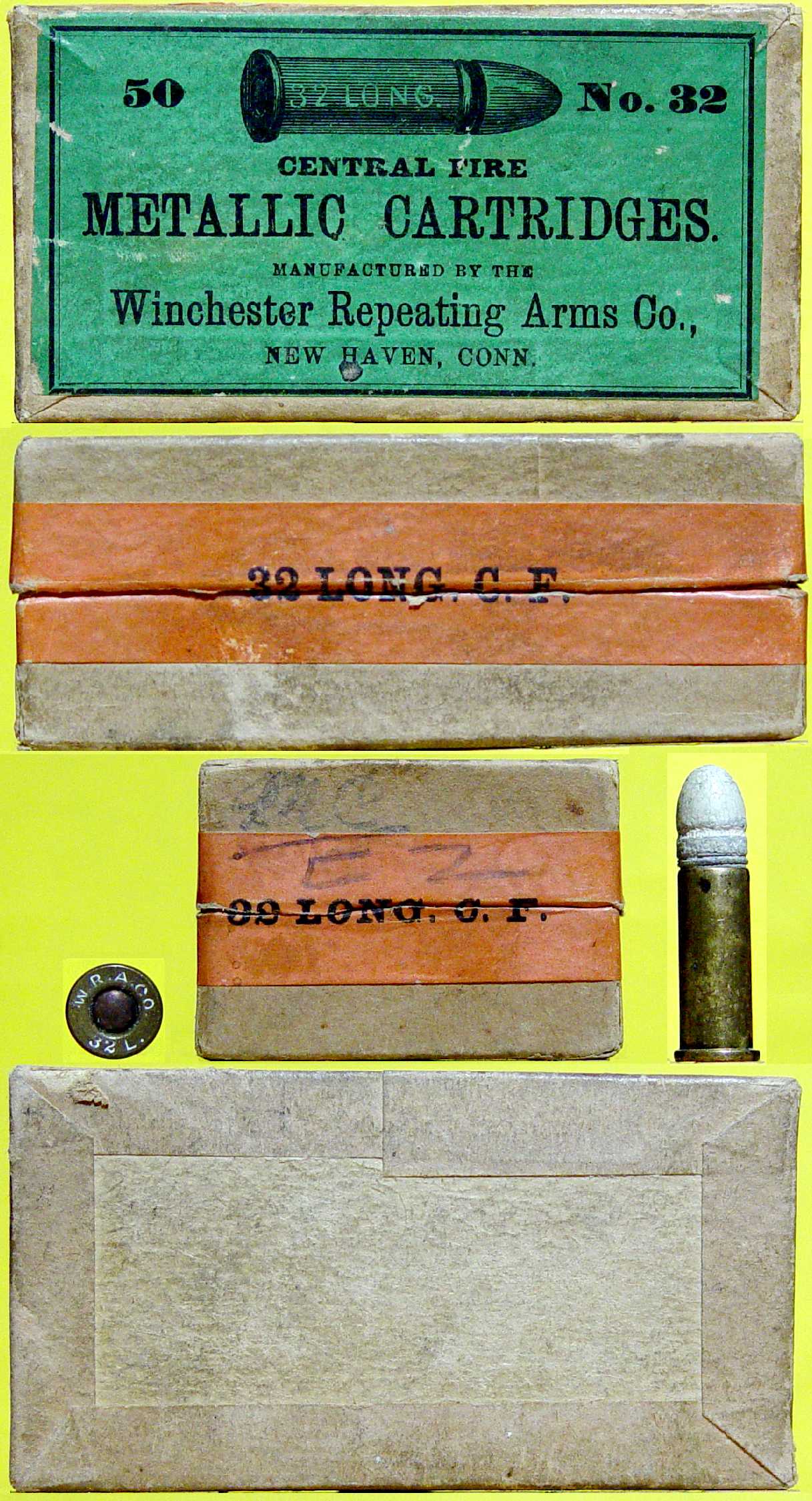 is a little longer than the British
cartridge. It can easily confused with a number of other American
cartridges, including the early.32 Long Colt with the outside lubed
bullet and the .32 long centerfire rifle, especially when trying to identify
an unheadstamped cartridge. Of course, headstamps tend to make
identification much easier,
although there was little consensus among the different headstamps used by
the ammunition manufacturers, so even those with headstamps can sometimes
cause problems. is a little longer than the British
cartridge. It can easily confused with a number of other American
cartridges, including the early.32 Long Colt with the outside lubed
bullet and the .32 long centerfire rifle, especially when trying to identify
an unheadstamped cartridge. Of course, headstamps tend to make
identification much easier,
although there was little consensus among the different headstamps used by
the ammunition manufacturers, so even those with headstamps can sometimes
cause problems.
This first box is the earlier of the two boxes discussed here, made
sometime in the mid-to-late1880s. The early characteristics of this box include
the caliber designation as No. 32 Central Fire, and the lack of a mention on the
side-sealing label of the firearms (Webley and Tranter, or Colt,
Webley and Tranter) for which the cartridge was adapted. It is interesting
to see the 'No. 32' used on a centerfire box, as this is typically seen on
early Winchester rim fire boxes. While the cartridge illustrated on the
label is unheadstamped, the cartridges in the box have the early
style headstamp which has a narrow space between the '32' and the 'L.';
later headstamps will have a noticeably wider space. Winchester began
applying headstamps in the mid-1880s.
.
.
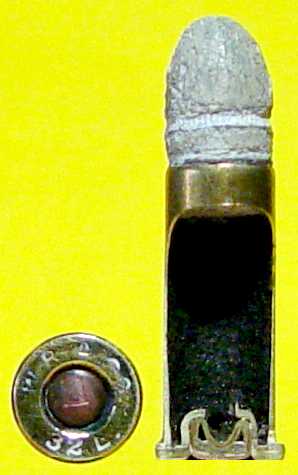
These cartridges with the narrow space headstamp have the early style
cases with folded heads, as can be seen on the sectioned cartridge in this
photograph. These were produced using many of the same processes that the
company used in making its rimfire cases. Thomas G. Bennett , Oliver
Winchester's son-in-law and an officer in the company who became President
in 1890, was issued U.S. Patent 224,765 on February 24th, 1880 for a process
to produce solid head, drawn cartridge cases. While solid head cases were
not immediately utilized for all cartridge production, it can be assumed
that Winchester was using them on most of their cartridges by 1890. The
copper primer used for these cartridges is the Winchester # 1 1/2 primer
produced under U.S. Patent 208,589, issued to John Gardner, Winchester's
cartridge superintendent, on October 1st, 1878.
.
.
The box shown below is most likely the last box style produced by
Winchester for this cartridge before it was dropped from the catalog around
1904. Late characteristics include the caliber designation '32 Long Center
Fire'. The cartridge
on the label now has 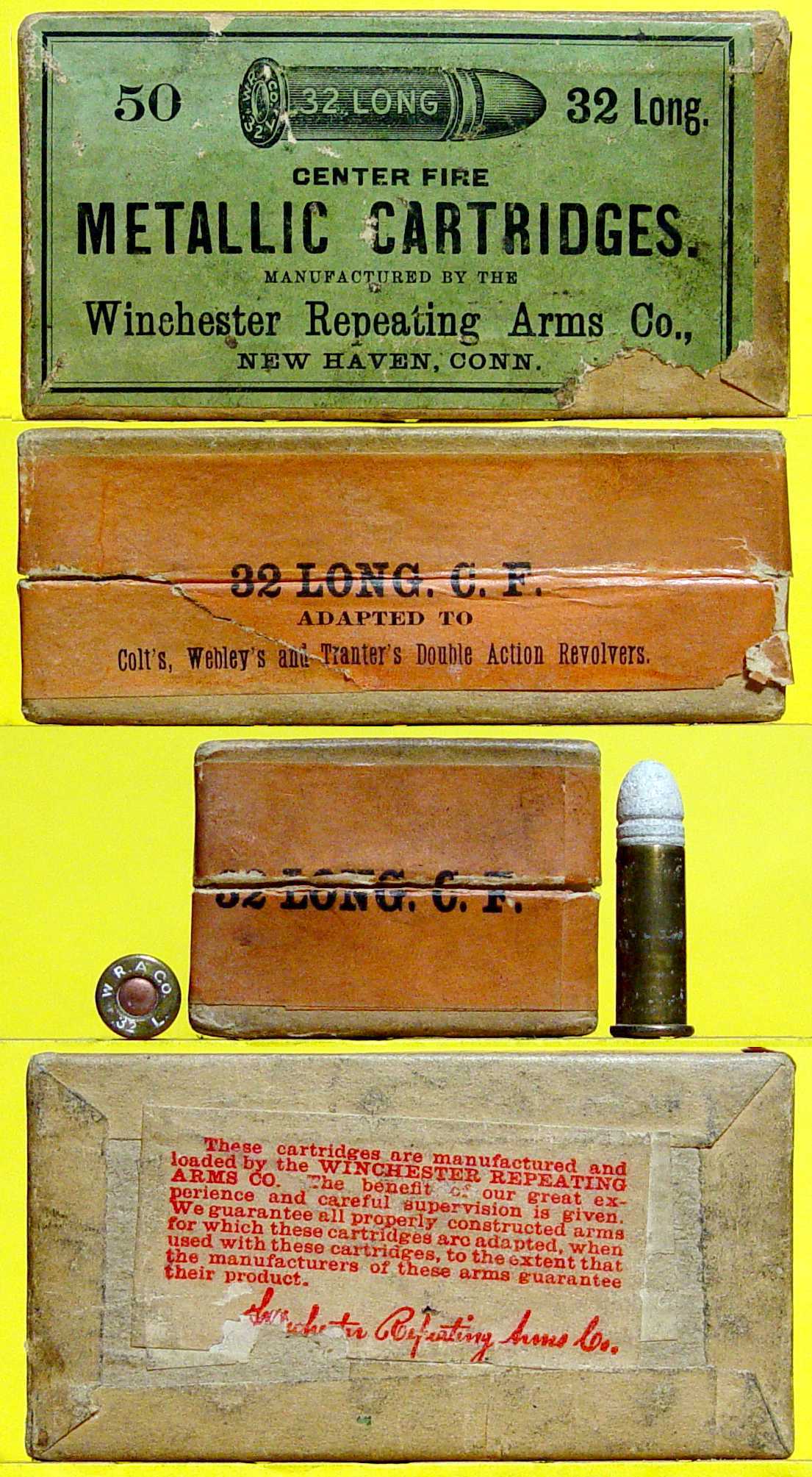 two grooves approximately the same width rather than
the single wide groove, and it has a headstamp. The side label includes
'ADAPTED TO Colt's, Webley's and Tranter's Double Action Revolvers', which
indicates that the box was made after about 1900, when Colt was added to the
label; prior to this, only the Webley and Tranter revolvers were mentioned.
One other difference in this box from the earlier one is the addition of a
label on the bottom which extols Winchester's experience in ammunition
production, and includes a rather empty guarantee: 'We guatantee all properly
constructed arms for which these cartridges are adapted, when used with
these cartridges, to the extent that the manufacturers of these arms
guarantee their product'. two grooves approximately the same width rather than
the single wide groove, and it has a headstamp. The side label includes
'ADAPTED TO Colt's, Webley's and Tranter's Double Action Revolvers', which
indicates that the box was made after about 1900, when Colt was added to the
label; prior to this, only the Webley and Tranter revolvers were mentioned.
One other difference in this box from the earlier one is the addition of a
label on the bottom which extols Winchester's experience in ammunition
production, and includes a rather empty guarantee: 'We guatantee all properly
constructed arms for which these cartridges are adapted, when used with
these cartridges, to the extent that the manufacturers of these arms
guarantee their product'.
.
.
.
.
Label on the inside of the top:
.
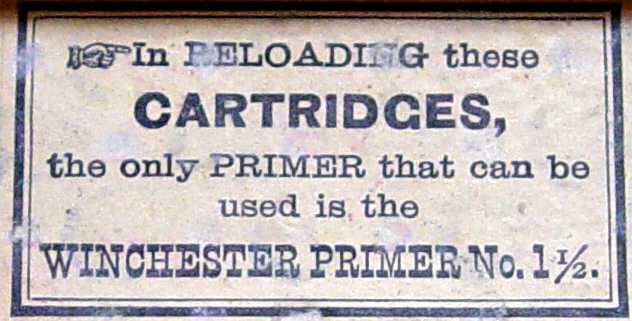
.
.
.
.
.
.
.
.
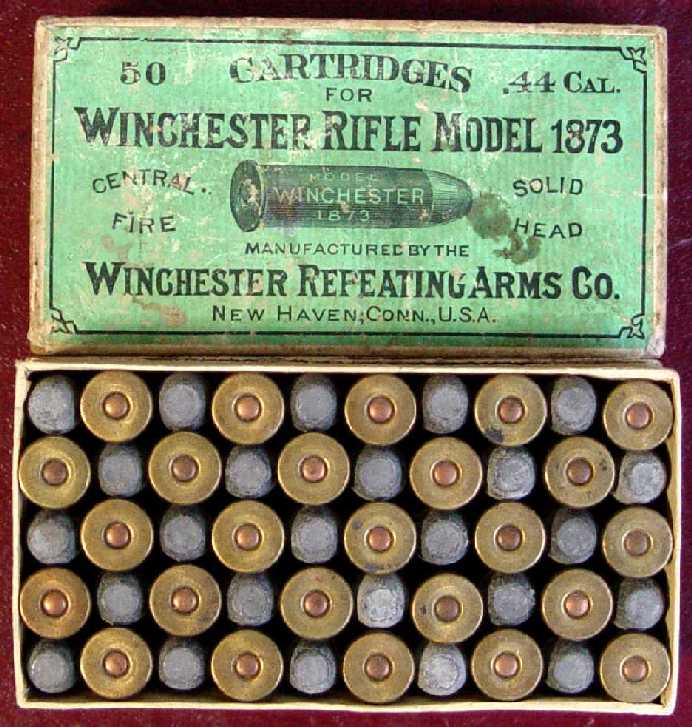
|


 ball
load. Both have a paper sabot with a cup in each end, one for the
shot or ball to seat in and the other holding a disc of priming
compound. The powder charge is situated below the base of the wad. All of
the inner components are wrapped in a paper envelope that is closed at the
base and twisted or tied at the mouth. Attached to the thin paper base is a
cardboard disk with a hole in the center, the disk serving to protect the
fragile base as well as to form the rim. The needle, essentially a long
sharp firing pin, passes through the hole in the disk and through the powder
charge, striking the priming in the base of the wad with sufficient force to
detonate it and the powder charge. These two cartridges are
uncharacteristically shiny due to a previous owner having coated them with
shellac. The sabots in both are evident as the whiter-colored center portion
of the cartridge.
ball
load. Both have a paper sabot with a cup in each end, one for the
shot or ball to seat in and the other holding a disc of priming
compound. The powder charge is situated below the base of the wad. All of
the inner components are wrapped in a paper envelope that is closed at the
base and twisted or tied at the mouth. Attached to the thin paper base is a
cardboard disk with a hole in the center, the disk serving to protect the
fragile base as well as to form the rim. The needle, essentially a long
sharp firing pin, passes through the hole in the disk and through the powder
charge, striking the priming in the base of the wad with sufficient force to
detonate it and the powder charge. These two cartridges are
uncharacteristically shiny due to a previous owner having coated them with
shellac. The sabots in both are evident as the whiter-colored center portion
of the cartridge.  design
of the NATO flag. It is supposed to be used only on ammunition produced at NATO-approved
facilities in member countries, and indicates that the ammunition meets
strict interchangeability standards for velocity, chamber pressure, barrel
erosion, waterproofing, and a number of other characteristics.
design
of the NATO flag. It is supposed to be used only on ammunition produced at NATO-approved
facilities in member countries, and indicates that the ammunition meets
strict interchangeability standards for velocity, chamber pressure, barrel
erosion, waterproofing, and a number of other characteristics. is a little longer than the British
cartridge. It can easily confused with a number of other American
cartridges, including the early.32 Long Colt with the outside lubed
bullet and the .32 long centerfire rifle, especially when trying to identify
an unheadstamped cartridge. Of course, headstamps tend to make
identification much easier,
although there was little consensus among the different headstamps used by
the ammunition manufacturers, so even those with headstamps can sometimes
cause problems.
is a little longer than the British
cartridge. It can easily confused with a number of other American
cartridges, including the early.32 Long Colt with the outside lubed
bullet and the .32 long centerfire rifle, especially when trying to identify
an unheadstamped cartridge. Of course, headstamps tend to make
identification much easier,
although there was little consensus among the different headstamps used by
the ammunition manufacturers, so even those with headstamps can sometimes
cause problems. 
 two grooves approximately the same width rather than
the single wide groove, and it has a headstamp. The side label includes
'ADAPTED TO Colt's, Webley's and Tranter's Double Action Revolvers', which
indicates that the box was made after about 1900, when Colt was added to the
label; prior to this, only the Webley and Tranter revolvers were mentioned.
One other difference in this box from the earlier one is the addition of a
label on the bottom which extols Winchester's experience in ammunition
production, and includes a rather empty guarantee: 'We guatantee all properly
constructed arms for which these cartridges are adapted, when used with
these cartridges, to the extent that the manufacturers of these arms
guarantee their product'.
two grooves approximately the same width rather than
the single wide groove, and it has a headstamp. The side label includes
'ADAPTED TO Colt's, Webley's and Tranter's Double Action Revolvers', which
indicates that the box was made after about 1900, when Colt was added to the
label; prior to this, only the Webley and Tranter revolvers were mentioned.
One other difference in this box from the earlier one is the addition of a
label on the bottom which extols Winchester's experience in ammunition
production, and includes a rather empty guarantee: 'We guatantee all properly
constructed arms for which these cartridges are adapted, when used with
these cartridges, to the extent that the manufacturers of these arms
guarantee their product'. 